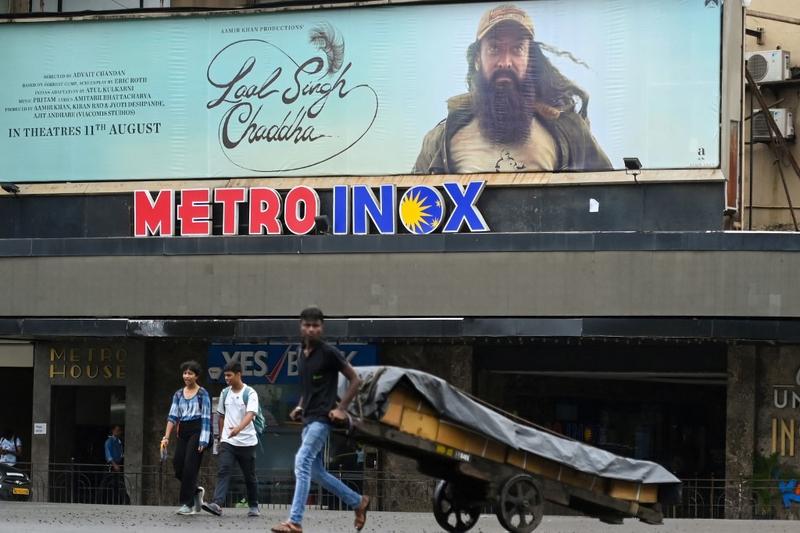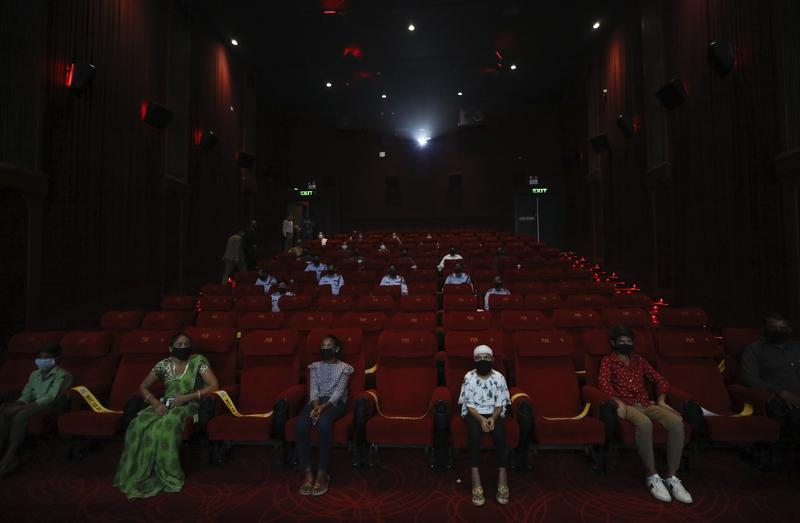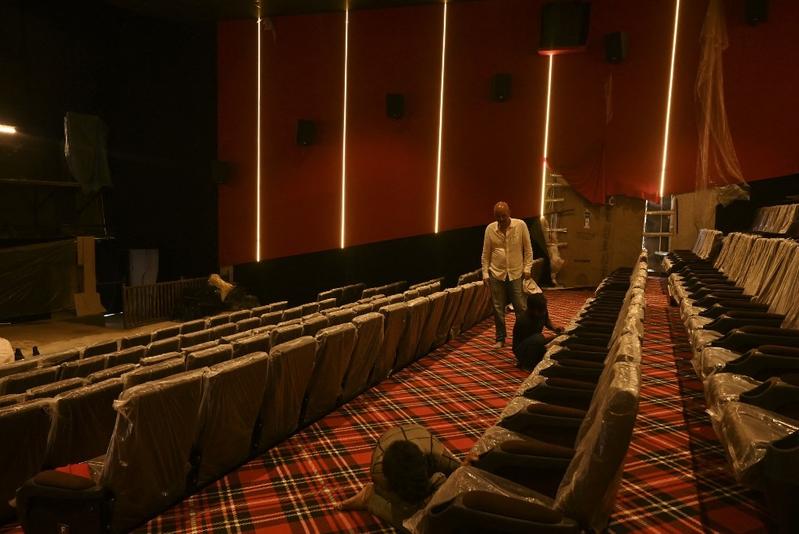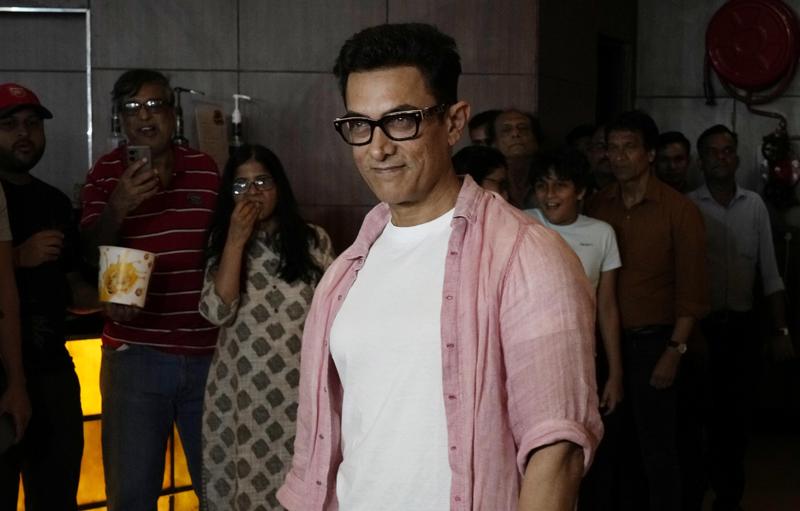 Pedestrians walk past a poster of the Bollywood film "Laal Singh Chaddha" put up at the Metro theater in Mumbai on Aug 8, 2022. (PUNIT PARANJPE / AFP)
Pedestrians walk past a poster of the Bollywood film "Laal Singh Chaddha" put up at the Metro theater in Mumbai on Aug 8, 2022. (PUNIT PARANJPE / AFP)
MUMBAI - Bollywood may be broken, and it has itself to blame.
That's the verdict of one of its biggest and brightest stars after the latest flop in a Hindi-language movie industry that's long mesmerized Indians, and the world, with its dazzling all-singing, all-dancing brand of big-screen escapism.
"Films are not working - it's our fault, it's my fault," Akshay Kumar told reporters last month after his new movie "Raksha Bandhan" tanked at the box office. "I have to make the changes, I have to understand what the audience wants. I want to dismantle the way I think about what kind of films I should do."
The rise of streaming services like Netflix and Amazon Prime during the COVID-19 pandemic has conspired with growing Bollywood fatigue among younger generations who view many of its movies as outdated and unfashionable
Indeed times have changed and Bollywood, a cultural pillar of modern India, is losing its allure.
ALSO READ: Girl power
The rise of streaming services like Netflix and Amazon Prime during the COVID-19 pandemic has conspired with growing Bollywood fatigue among younger generations who view many of its movies as outdated and unfashionable.
Of the 26 Bollywood releases this year, 20 - or 77 percent - have been flops, defined as losing half or more of their investment, according to the Koimoi website, which tracks industry data.
That's about double the failure rate of 39 percent in 2019, before the pandemic shook up society and forced hundreds of millions of Indians to wean themselves off cinemas, for decades the bastion of Bollywood and its main source of revenue.
Christina Sundaresan, a 40-year-old mother of two teenage girls in Mumbai, used to see at least one Bollywood movie a week in the cinema before the pandemic. Now she rarely goes.
READ MORE: A new world on the Indian online horizon
"I mean, they are okay to watch when you need a laugh but I would not go to a theater for them," she said. "My daughters used to watch every movie with us, but now they're not interested either. They are very much into Korean shows and series which air on these streaming platforms."
 People watch a Bollywood movie at the PVR movie theater in New Delhi on Oct 15, 2020. (MANISH SWARUP / AP)
People watch a Bollywood movie at the PVR movie theater in New Delhi on Oct 15, 2020. (MANISH SWARUP / AP)
They're not alone in converting to international streaming services, which came to India relatively late - Netflix and Amazon Prime launched in 2016 - offering varied content made in America and Europe as well as India and elsewhere in Asia, from Parasite and Avengers to Squid Game and Game of Thrones.
A quarter of India's 1.4 billion people now use such services, up from about 12 percent in 2019, according to market data firm Statista. The figure is expected to hit 31 percent by 2027, and there's room to grow; take-up is about 80 percent in North America, for example.
So what’s the problem?
Indian box-office revenues had risen every year for a decade to reach around US$2 billion in 2019 before slumping during the pandemic. They show little sign of bouncing back.
Ticket sales have fallen every month since March this year, sequentially, industry trackers show. Revenues from Bollywood films specifically are expected to fall 45 percent in the July-September quarter versus pre-COVID levels, according to research from investment banking firm Elara Capital.
READ MORE: India's top investigation agency to probe film actor's death
Bollywood can no longer take audiences for granted and has to adapt if it hopes to survive and thrive, according to Reuters interviews with film fans, as well as half a dozen industry players including producers, movie distributors and cinema operators.
Four of the executives painted a picture of confusion and worry in the industry as studios release films that were supposed to hit the market before the pandemic struck and consumer taste evolved with the rise of streamers, known in India as OTT or over-the-top services.
Producers are racing to rework scripts and considering linking actors' fees to box-office performance instead of handing over an upfront payment, said Rajender Singh Jyala, chief programming officer at India's second-biggest multiplex operator INOX , citing his discussions with filmmakers.
"No one knows what the actual problem is," he added. "During the pandemic there were no releases, everything was shut and people had a lot of time to watch on OTT and to watch different kinds of content. So what would have worked two years ago, that content is not worth today's time."
 Laborers work at the construction site of "INOX" cinema theater in Srinagar on Aug 11, 2022. (TAUSEEF MUSTAFA / AFP)
Laborers work at the construction site of "INOX" cinema theater in Srinagar on Aug 11, 2022. (TAUSEEF MUSTAFA / AFP)
Yet it's not all doom and gloom, say Jyala and other executives. There's no turning back the clock to Bollywood's heyday, but they say a few big hits could breathe new life into the industry and that it could ultimately find a new balance with streaming services and the money they bring to the table.
ALSO READ: Actor's suicide sparks debate about insularity in Indian film industry
Nonetheless, executives must adapt quickly.
The storyline is the issue and since the past two years the audience has been exposed to so many new themes and they have been introduced to new concepts as well, so that is why I guess Bollywood is lacking in that area
Vaishnavi Sharma, College student
Indian films rely on cinemas for nearly three-quarters of their revenue, researchers at OP Jindal Global University near New Delhi found. By contrast, movies globally draw less than half of their income from box offices, according to data from America's Motion Picture Association.
“Storyline is the issue”
Fans of Bollywood, a century-old institution, say it can evolve to stay relevant. Recent shifts to better reflect society include the introduction of gay relationships and characters who change their gender, for example.
For New Delhi college student Vaishnavi Sharma, studios simply need to step up their game.
"The storyline is the issue and since the past two years the audience has been exposed to so many new themes and they have been introduced to new concepts as well, so that is why I guess Bollywood is lacking in that area," she said.
READ MORE: India star Aishwarya virus positive, joining father-in-law, husband
The writing was on the wall last month when a pair of big-budget movies bombed despite starring two of Bollywood's box-office darlings, Kumar and Aamir Khan.
The poor showing of Kumar's "Raksha Bandhan", about the bond between a brother and his sisters, provoked the actor's comments about films not working.
Khan's "Laal Singh Chaddha", a remake of 1994 Hollywood hit "Forrest Gump", has only made around 560 million rupees in ticket sales - about a quarter of its budget - despite being released on Aug 11, on the eve of a festive long weekend.
 Bollywood actor Aamir Khan attends an informal trailer preview of his movie "Laal Singh Chaddha" in Mumbai, on May 28, 2022. (RAJANISH KAKADE / AP)
Bollywood actor Aamir Khan attends an informal trailer preview of his movie "Laal Singh Chaddha" in Mumbai, on May 28, 2022. (RAJANISH KAKADE / AP)
The flops represented steep reversals for the two A-listers, action and comedy favorites whose films have been known to recover all costs within the first week over the years.
The cost of going to the cinema is another key issue cited by film fans and industry players at a time when India, like much of the world, is wrestling with a cost-of-living crisis
INOX's Jyala said the multiplex was reducing the number of showings of Laal Singh Chaddha by a quarter because of its poor performance.
A senior Bollywood producer, who has two big-budget movies lined up for release, told Reuters on condition of anonymity that producers were "re-calibrating everything" for new projects in the works, from budgets and scripts to the choice of actors.
"We have to adapt to audiences and what they want," said the producer, but added: "I don't have the answers anymore."
“Cut off from the masses”
The cost of going to the cinema is another key issue cited by film fans and industry players at a time when India, like much of the world, is wrestling with a cost-of-living crisis.
A big-screen movie outing can typically cost a family of four 3,000 to 5,000 rupees (US$35-US$60), a high price in a nation where many people live in poverty, the average annual income is about 160,000 rupees and the monthly subscription fee for streaming services like Netflix starts at about 150 rupees.
"There has to be a correction somewhere - budgets need to be reworked and the cost of going to the movies also has to reduce," said Anil Thadani, who owns a film production and distribution company and is married to Bollywood actress Raveena Tandon.
"The Hindi film industry is making films that are cut off from the masses. A large part of our population doesn't always identify with these films."
This sentiment was echoed by Sundaresan, the mother of teenage girls in Mumbai.
ALSO READ: Veteran Bollywood actor Rishi Kapoor dies of cancer
"Going to a theater, sitting in one seat and not watching a movie at your own pace seems like a waste of time now," she said. "There are so many better things to watch on OTT."
Karan Taurani, media analyst at Elara Capital, said he expected a rebalancing in the fees paid to leading actors, with most producers moving towards a revenue-sharing model and more of a film's budget going on production and special effects.
"It has been more than five months that cinemas have been fully functional and only three films have been hits – and all these three are not by large stars," he added.
There will be no immediate Bollywood overhaul though, Taurani cautioned.
"The shake-up will happen early next year when the current crop of films which were made during and before the pandemic will be done."


